
Hi Gang…
Thanks goes to Harold Pace, noted author and great friend, for directing me to the source of today’s article.
Today’s article from Car and Driver Magazine in ’71 gives great insight into the state of the fiberglass sports car industry just 20 years after ‘glass cars were introduced at the November ’51 Petersen Motorama in Los Angeles, California.
Reviewing The Contents:
This article is divided into two areas:
* The first half is a comprehensive article which identifies the tools, experience, insurance, licensing, time, and real costs associated with building a sports car in the early ‘70s.
* The second half is a “Buyers Guide” showing all of the sports cars and “sporty” cars available at the time – excluding most Dune Buggies which were nearly at their zenith of popularity. The pictures and their associated information in the “Buyers Guide” appear throughout the story. Use your mouse and click on any of these pictures to make them larger and more easily readable.
There is some excellent information shared here in Car and Driver Magazine, and this article represents what the “state of the industry” looked like for the “build it yourself” fiberglass sports car hobby going forward from 1971. A bit of history concerning cars such as “Devin” was shared, but their assertion that Devin started to build fiberglass cars in ’47 was a bit too early. So far, our research has shown that Devin’ started with his ’55 Devin-Panhard, and then in ’56 launched his now famous multi-sized body.
What’s interesting is that Kellison – a company covered in this article and still active at the time (not the case with “Devin” in the Buyer’s Guide) started in ’57 (perhaps earlier….still researching and confirming), and this history is not mentioned. Nor is “Fiberfab” which started around ’64 with roots earlier in “Sports Car Engineering” in the late ’50s or CRV which started being advertised around ’65.
So…as you can see….the focus of this article was “how it was in ’71” – not history.
As Harold Pace promised, this article is definitely worth the read, and covers details of 18 sports cars kits that could be purchased including:
- Amante GT (Performance Designers)
- Avenger GT-12 (Fiberfab)
- Bradley GT (Bradley Automotive)
- CRV (Sportsland Unlimited)
- Humbug (American Fiberglass)
- Jamaican (Fiberfab)
- Jamaican V8 (Fiberfab)
- GT-40K (Kellison)
- Laser GT (Elite Enterprises)
- Lotus Seven (Lotus Central)
- Marauder GT (Randy Berry)
- Maxi-Taxi (Bremen Sport Equipment)
- Meyers Manx SR (B.F. Meyers & Company)
- Shala (House of Shalako)
- Shala-Vet (House of Shalako)
- Shark (Kellison)
- Targlia Mark II (Ye Olde Classic Touring)
- Valkyrie GTX (Fiberfab)
Reviewing the Article:
Here’s a sample of the solid advice given to the “would be” sports car builder as discussed in the article below:
“The better your facilities and working space are, the shorter your project time will be. Total time can vary from 20 hours for the Lotus Seven or Fiberfab Avenger (pre-assembled), to several years of weekends and evenings for the more involved kits. Unless you are J. Paul Getty, cost will be a serious consideration.
The advertised kit price may seem exorbitant but realize it is only the visible tip of the iceberg. An accurate estimate prior to committal is a desirable but unattainable figure…..”
As you can see, the article was right on target concerning the time it might take (more than one year was mentioned) and the dedicated financial cost. Eighteen sports cars were discussed and I’ve shown each of these with the specifications in the story below. So…let’s get to it and see what they had to say about the state of the industry in ’71.
Take it away, “Car And Driver” Magazine….
Getting Into It: Car and Driver Magazine, November 1971
Before You Sign An Order Blank, Realize That It Takes More Than A Bit of Experience And A $38.85 Set Of Tools To Build A Kit Car
Perhaps you’re finally tired of the “classic” lines of your ’64 Beetle. It still manages 25 mpg but finding it in a parking lot is a very real hassle. Or maybe you just rolled the Bug into a ball. A ball of your very own since the insurance agent doesn’t answer his phone anymore.
Maybe you’re just ready for something new, but Detroit doesn’t have time to build a car that will fill your needs as well as those of every politician aspiring to be President. There are always the imports. Very possibly a reasonable solution but every red-blooded American must cringe to think of our gold flowing away as each car is unloaded from the boat.
Or there is the chance that individuality is your bag and you wouldn’t consider a supermarket variety automobile under any circumstances. Whatever your current automotive predicament, consider a kit car as a viable alternative to that “real” car you’ve been less than happy with.
With its concerns for the environment and safety, one might think the Federal government would have legislated home-built cars out of existence long ago. However, the Feds tentacles have not yet closed that small loop-hole and only the big-time manufacturers are susceptible to the safety and emission laws (to qualify for this select group, a company must sell 500 or more completed cars per year).
Until Washington sets its regulating sights on this still unrestricted portion of our lives, you can still choose from a diverse range of kit cars. In our search and examination mission we have excluded dune buggies or any car not well-suited for the highway and a wide range of weather conditions.
The results are presented on page 35. We found it’s not all wine and roses in the world of attaching sub-assembly B-42 to assembly 19. A serious investigation and self-evaluation is at hand before your enthusiasm has you signing the dotted line.
One of the first observations we made was that every kit but one features a fiberglass body. This space age material has been around for only 25 years and was orginally developed by chemical companies (for obvious reasons).
It is ideal for low production volumes and the intricate shapes aesthetically necessary. All bodies are a bonded mixture of fiberglass (chopped strands or cloth) and polyester resin. If one wants to ferret out the originator of this type of construction, Bill Devin should be seriously considered for paternity suit papers.
His work first became available in 1947 and may still be found on the street, at the dragstrip and dry lake–or lying flaccid in the upper levels of corn cribs. The most popular Devin body was a simple shell, styled after the Ferrari Testa Rosa. They were available in different widths and wheelbases to accommodate nearly any contemporary chassis from an MG to a Studebaker Landcruiser.
Complete finishing for a reasonable street car required a “Golden Hammer” craftsman but the light weight bodies became well known because they were ideal for a variety of racing applications. One can no longer buy a new Devin body (probably the best for everyone) as the creditors took their toll in the early Sixties.
From these meager beginnings, the fiberglass body industry has taken great strides. Today there are several kits which are quite well detailed. Unfortunately there are still potential corn crib dwellers–“cars” that are little more than a poorly executed shell guaranteed to generate embarrassment and extra income for the nearest marriage counselor.
The market stimulus provided by the dune buggy craze has resulted in a number of backyard here-today-gone-tomorrow operations. Even established kit manufacturers are guilty of not waiting for final development before their new products are lavishly portrayed in brochures and displays to entice the unsuspecting buyer.
When considering a sizable financial outlay in this market (from $375 to $3395 for the kit alone), we recommend the utmost caution–better yet if that caution is steeped in knowledge. A variety of kits are offered in a full range of price, quality, detail, and degree of finish. The primary considerations are the ultimate application for the finished car, the time and facilities available for construction, and the money you are willing to part with.
Financial considerations aside, the mental turmoil can be reduced to a very simple decision: whether you are looking for a project or a car. Fortunately, threre are solutions to both. Project kits abound and they can be lengthy enough to allow instant, long lasting relief from a nagging wife.
For those who really want a car but don’t mind a few hours of wrench turning, the Lotus Seven may be the answer (see page 40). This kit, and a few others, will give you the full, suitable for framing, car constructor accreditation for the least expended effort. Also in this category are the prefinished kits. They feature factory wiring, doors that latch, roll-up windows, and completely finished interiors. A VW Beetle floorpan serves as chassis for many of these, greatly reducing construction time.
The shorter wheelbase will result in more responsive handling but an 80.0-inch length is not recommended for extensive highway use. Kits that make use of a full-length floorpan can eliminate chassis construction entirely and are becoming more prevalent.
We’ve also discovered a convenient rule of thumb for estimating construction time and difficulty of the project-type kit. In general, the time required is inversely proportional to the length of the instruction manual. In other words, the longer and more detailed the manual, the shorter your fabrication time will be.
Those manufacturers conscientious enough to provide dimensional drawings and templates have eliminated the unsolvable problems, but, if you want a challenge, it’s still on tap.
If you decide to buy a “basic” kit, be prepared to fill your garage with tools. Some arc welding is nearly always required. This can be subcontracted but it isn’t going to be free. Gas welding equipment and some operating proficiency will greatly facilitate fabricating the multitude of small mounting brackets and exhaust system components. Access to a lathe and milling machine will benefit the quality and appearance of home-made items.
You will undoubtedly need a wealth of small power tools. Various size electric drill motors, a sabre-saw, a hole saw, and an orbital sander are the absolute minimum. As for hand tools, the more you have, the easier your task will be. Fortunately fiberglass itself is quite easy to work with. Some bonding may be required but the process is very straightforward even for the uninitiated.
We highly recommend optional assembly completion packages because they eliminate most of the fabrication. They should be bypassed to save money only by experienced craftsmen.
Many pieces may not be included in your kit and will have to be obtained elsewhere. If they are standard automotive components, a salvage yard may be the best source. Unfortunately, one must also tread lightly in this area, since many junkyard proprietors are less than scrupulous.
A friendly relationship should be developed for best results. Just examining their merchandise can provide valuable insight into the Detroit solution for a number of problems you will encounter. And a salvage yard’s teletype system can produce virtually any part you can name. Knowledge of a part’s new value can be the best bartering tool for a fair price on a used part.
Many items must be new to insure a safe finished car. Too much care cannot be exercised in braking, steering, and suspension systems. Only steel should be used for stationary brake lines and a double flare should be formed at all junctions. The special tool and procedure for this step is described in almost any service manual for a domestic car.
All fasteners should be new for best results. Stove bolts from the local hardware store are inadequate since at least SAE grade 3 strength is required even in relatively noncritical applications. For high stress areas such as suspension mountings, steering linkage, and engine mounts, grades 5 through 8 should be used.
SAE grade bolts are available through major industrial suppliers. Pessimists may wish to use vastly superior aircraft quality fasteners which are available through war surplus dealers.
The project nature of your kit will determine the space required. The Lotus Seven could easily be assembled in a driveway. At the other extreme, a two-car garage would be the bare minimum for the most involved construction like the Valkyrie GTX. The better your facilities and working space are, the shorter your project time will be. Total time can vary from 20 hours for the Lotus Seven or Fiberfab Avenger (pre-assembled), to several years of weekends and evenings for the more involved kits.
Unless you are J. Paul Getty, cost will be a serious consideration. The advertised kit price may seem exorbitant but realize it is only the visible tip of the iceberg. An accurate estimate prior to committal is a desirable but unattainable figure. Major items and services can be predicted and some generous safety factors should then be applied.
All kits are subject to applicable state sales tax and whatever Federal taxes may be in effect at the moment. Shipping costs are constantly rising and are best avoided by taking delivery at a factory distributor. Truck lines will deliver the goods to your door for an exorbitant fee but not necessarily intact. No matter how many cost saving corners you cut, it is reasonable to plan on your kit car costing more than a comparable real car you could have driven off the used car lot.
Insurance should not be forgotten when considering the financial outlay involved. We found that for a fiberglass body. In addition, determining the real value of the car is nearly impossible and more than enough reason for agents to refuse theft coverage.
They will accept your premiums for liability insurance if you can present a favorable driving record, suitable age group, and acceptable (to them) power-to-weight ratio figures. Lloyd’s of London should take care of you if all else fails.
Assuming you’ve made the project kit versus the car kit decision and have accounted for the necessary time, money and facilities, you will be ready for the most difficult decision: choosing a particular kit and manufacturer. The C/D Buyers Guide (page 35) should direct you to the car you desire with some idea of its cost and construction difficulty.
Still, a careful look at the dealer and manufacturer is necessary before a decision can be made. If the dealer isn’t helpful right at the start, you’ll find his attention increasingly difficult to obtain after your check has cleared his bank. Seek out the reputable dealers.
Buying an instruction manual in advance will allow the most insight into the kit for the least investment. It should graphically demonstrate the care taken in the original design. Examine critical areas such as steering linkage. These design considerations vastly affect the ultimate nature of the car from a handling standpoint. Unless your wall is well decorated with engineering degrees, steering linkage is best left to the manufacturer.
A visit to your state’s licensing bureau is a very wise “before” investment. Most bureaus would like to have a manufacturer’s statement of origin before they will issue a new title or registration. This is not available in many cases, but your finished car can still be registered as a home-constructed vehicle.
All receipts (indicating serial numbers) for major components must be submitted in this instance. Most states will also require an inspection to verify that you have thoughtfully included safety related items. After a few reels of red tape and an inordinate taxing of your perseverance, every state can give you registration or title and license plates.
A finished kit car can be a very useful device but it is nothing compared to the satisfaction to be gained. Your cocktail party automotive engineering discussions will definitely take on a new credibility if you have successfully joined the ranks of Lee Iacocca, Colin Chapman, Alejandro de Tomaso and all those real car builders. Fortunately that is a very select group, but admission can be yours if you can allocate your abilities, facilities, and funds to match the requirements of whatever kit you select.
And, as always, should you decide to accept this assignment and fail, the members of this magazine will disavow all knowledge. Good luck.
Summary:
There was quite a bit of great information shared in the article – and a really cool “Buyers Guide” for 18 special cars….who could ask for more? Be sure to review all 18 small picture features in the “Buyers Guide” shown in the photo gallery above and below. Click on each picture to expand them and make them larger on your screen.
Great thanks goes to Harold Pace for sharing this wonderful find, and his consistent support and encouragement as we delve into the history of these unique automobiles and the special times and individuals that built them.
Hope you enjoyed the story, and until next time…
Glass on gang…
Geoff

——————————————————————-
Click on the Images Below to View Larger Pictures
——————————————————————-

























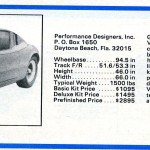
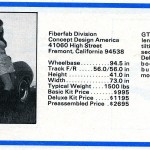
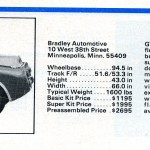
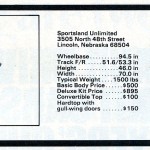
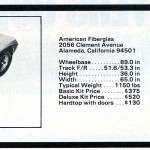
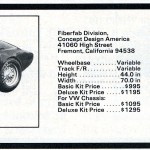
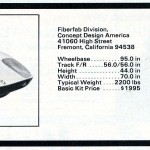
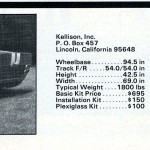
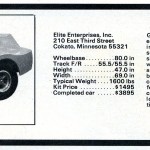
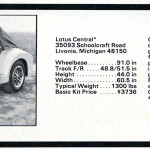
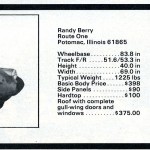
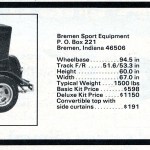
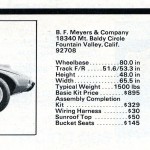

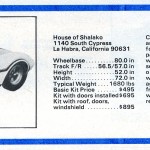
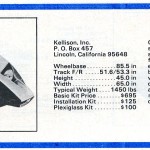
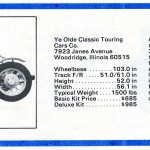
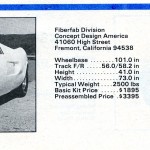

Hi Chuck… Elite Enterprises (Gerry Knapp) sold his whole company to Quint Industries (Raul Quintana) who sold just the Allard kit set-up to Hardy Motors (Neil Hardy). Hardy subsequently sold his improved upon Allard kit set-up to Roger Allard who started Allard Motor Works.
https://www.hagerty.com/articles-videos/articles/2013/03/12/Whats-in-a-name
Cheers. Neal
I own a 1952 Allard J2X reproduction kit car manufactured back in the 80’s by Elite Enterprises in Minnesota. They are now out of business. Does anyone know anything about the history of either the kit or the company. I would like to know how many J2X’s were manufactured and if the original mold were re-sold after Elite went OOB.
THANKS
Chuck Culver
how to find a serial numbers for a 1964 gt40 to get a title car was never reg in garage since 1964
In my high school days (1967-71 – the height of the muscle car era) American Fiberglass (which manufactured the Humbug) was 2 short blocks & around the corner from where I lived in Alameda, Ca. At times I could catch the resin aromas wafting into our neighborhood. My friends & I enjoyed going there & watching a schoolmate employed there blowing glass into the mold with the chopper gun. We also enjoyed checking out other running kit cars that would frequent the shop. These included the Avenger GT-12, Valkyrie GTX, Jamaican, & the Jamaican V8 all from nearby Fiberfab Division in Fremont as well as the Sterling manufactured in (even closer) San Leandro. But my personal favorite was a Cheetah that showed up one day while we were there! There were others too like the Bradley & assorted dune buggys, but there was no escaping that the cars that held the most dream appeal were the V8 powered kits.
What I appreciated back then was that there were so many different designs.It Seems nowadays it’s Cobra Porsche Ferrari or Lamborghini’s..Nothing original all copies or c
lones.. Of course not all of the early designs were all that great..
Mel
A lot had changed in the ten years since we sold Victress to LaDawri—most of it for the better. Real kits had been developed, simplifying construction. Some of the designs were near-beautiful, others not so much. Had we stayed in business, I’m sure Victress would have kept pace with the industry, or led it, in kit sophistication.
Merrill Powell
~ agreed, great article. written with depth of insight and subtle humor. loved the ‘rule of thumb’, -longer and more detailed the manual, the shorter your fabrication time…- perhaps more examples of fiberglass specials would exist today if both builders & manufactures had paid attention to this idea. we humans tend to underestimate difficulty inversely proportional to our enthusiasm. objectivity and excitement ought to be more compatible.
….. speaking only for myself, of course! (wink)
Terrific article, had completely forgotten that one, yet I enjoyed it back when it came out. Wonder how many of each of the kits was produced.